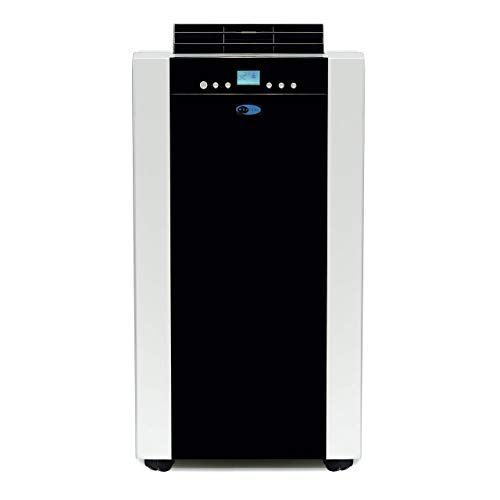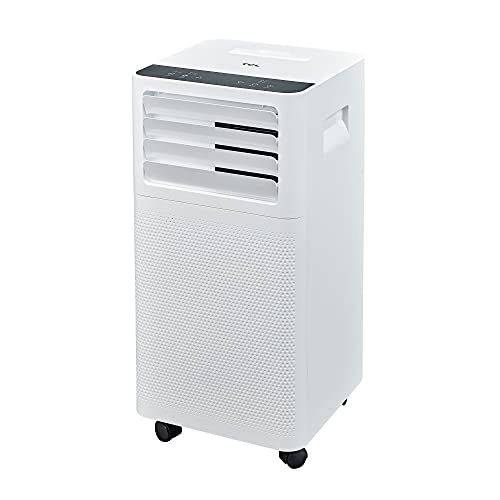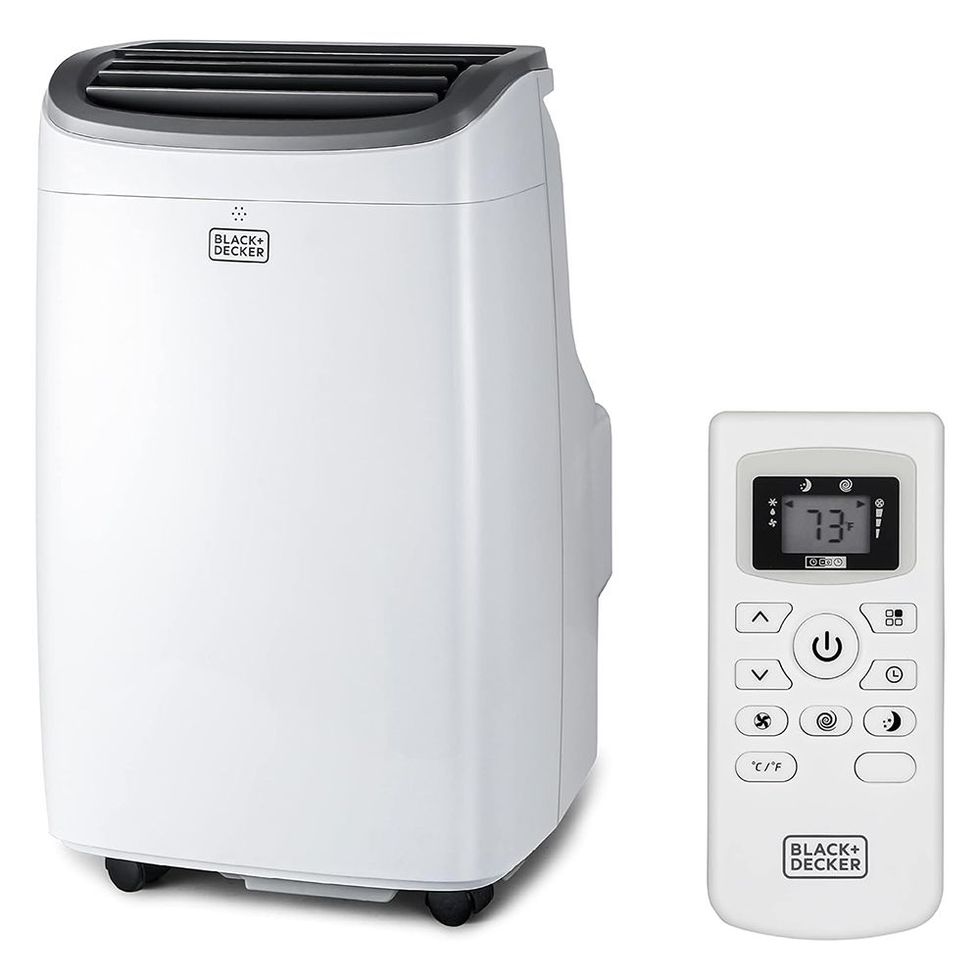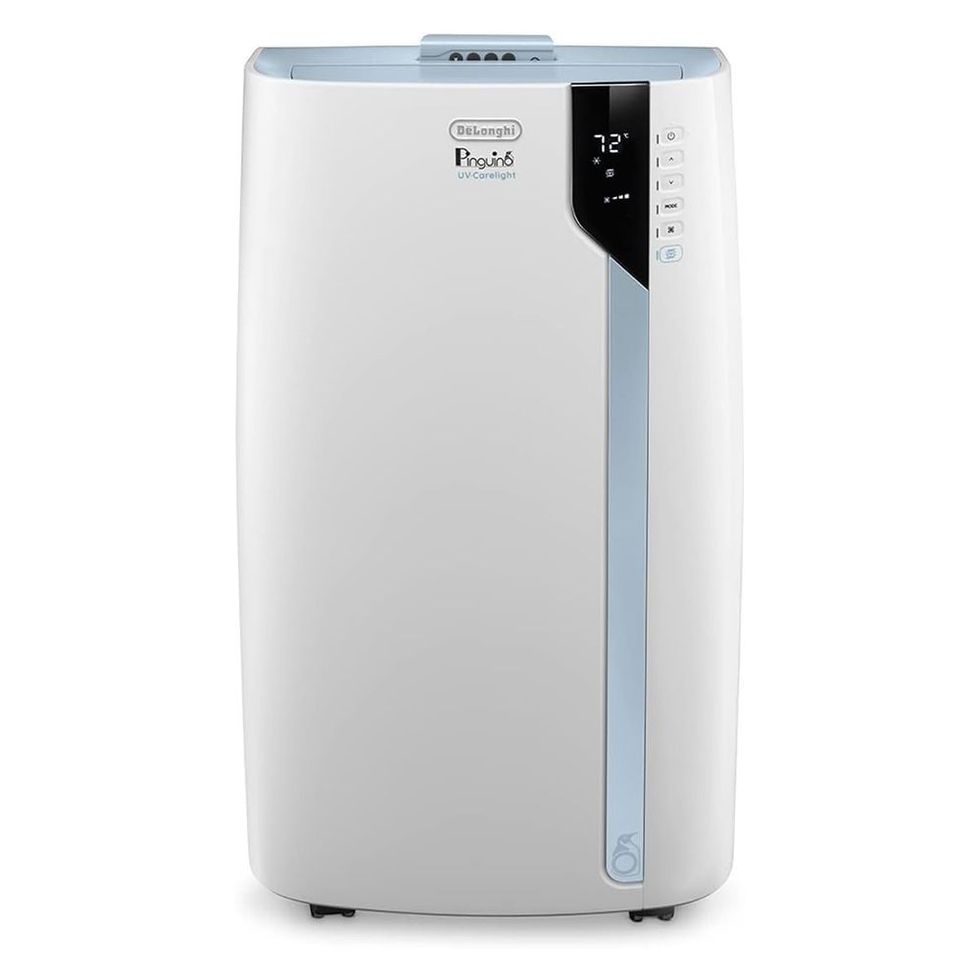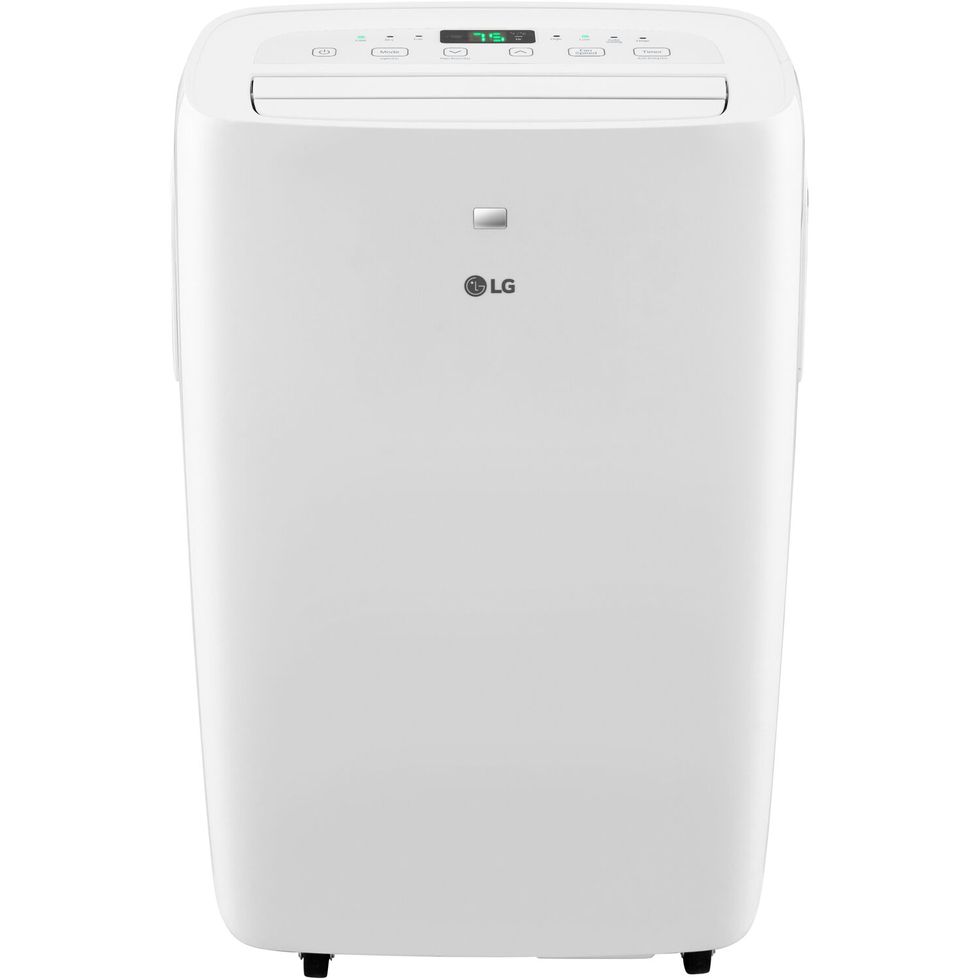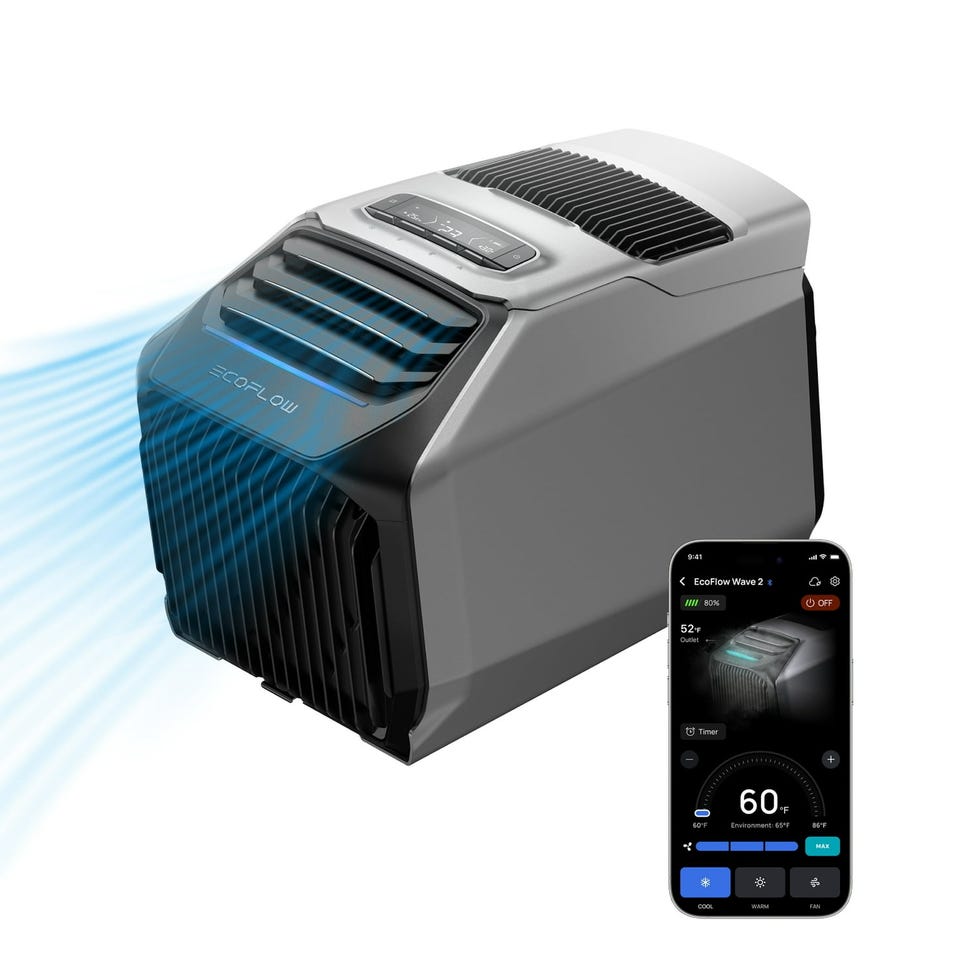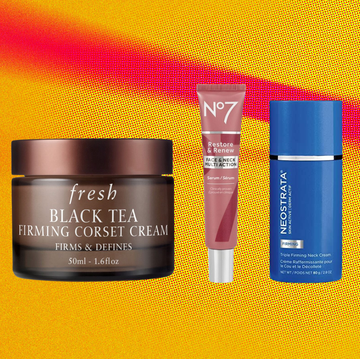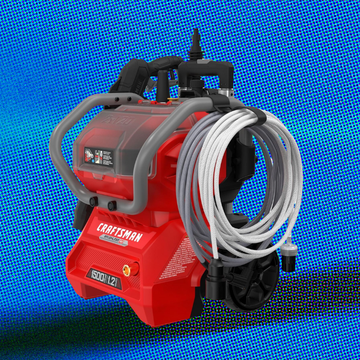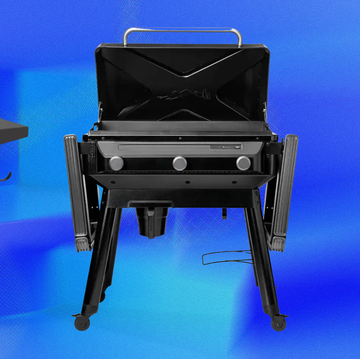8 Best Portable Air Conditioners, Tested and Reviewed
These top-performing ACs keep any room cool and humidity-free.
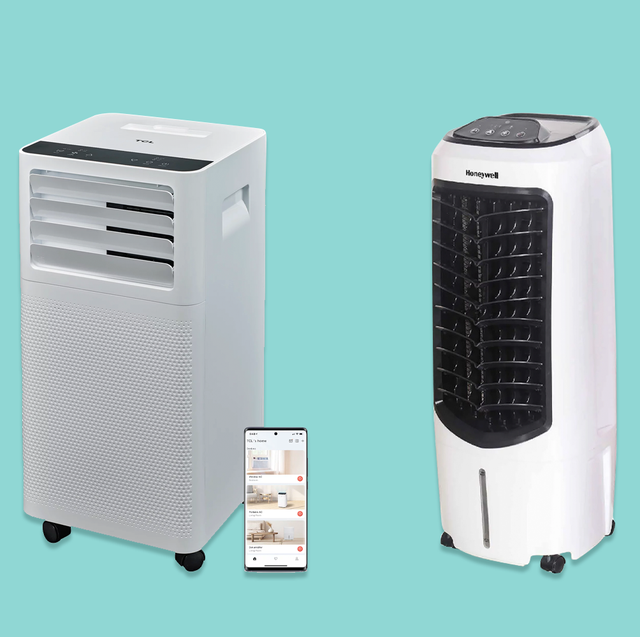
We've been independently researching and testing products for over 120 years. If you buy through our links, we may earn a commission. Learn more about our review process.
A portable air conditioner is just what it sounds like — a mobile device that delivers cool air where and when you need it most. These ACs are much cheaper than whole-house central air systems and don’t need to be parked on a window sill like a traditional room air conditioner. They'll also provide stronger cooling than a standing fan.
Our Top Pick: Based on extensive Lab and consumer testing, the Whynter Dual Hose Portable Air Conditioner is the best portable air conditioner for most people because of its versatility as it doubles as a dehumidifier.
For this report, the home improvement pros at the Good Housekeeping Institute reviewed and tested more than 30 portable air conditioners. Though central and room ACs still deliver top cooling power, the best portable ACs from our tests can maintain a comfortable 72º F during sultry weather and are simple to set up and operate.
After our top picks, you’ll find more details on how we test, plus what to consider when buying an air conditioner unit for your home.
Pros
Provides powerful cooling over large areas
Can also operate as a heater and dehumidifier
Relatively quiet
Cons
Slightly slower cooling than other models
BTU: 14,000 ASHRAE (9,500 SACC) | Exhaust type: Dual hose | Cooling area: 500 sq. ft. | Weight: 80 lbs | Dimensions: 16" x 19" x 35.5"
Why we love it: The Whynter's versatility makes it our top pick for most shoppers. For starters, it doubles as a dehumidifier, which is helpful since high indoor humidity often goes hand-in-hand with soaring temperatures. "In dehumidifier mode, the AC removed up to 101 pints of moisture in a 24-hour period," said Alec Scherma, a test engineer at the Good Housekeeping Institute, where he reviews a slew of devices related to home comfort.
Standout features: User-friendly features include a digital display that makes it easy to monitor temperatures and the 5-foot-long exhaust hose gives you some flexibility in terms of placement within a room.
How it performed in our tests: Boasting an impressive 14,000 BTUs, this powerful yet relatively quiet portable AC performed capably across our tough performance tests. Testers liked the programmable timer that lets you set a schedule for the day, for example, programming the AC to turn on 30 minutes before you'll be home from work.
How it compares: You'll pay more for its dual-hose design, but that helps it condition spaces effectively and efficiently (though it cooled slightly slower than other dual-hose models in our roundup).
Pros
Powerful air flow
Cools extremely fast
Remote or app connectivity
Cons
Can be loud on max fan settings
BTU: 7,500 ASHRAE (5,000 SACC) | Exhaust type: Single hose | Cooling area: Up to 200 sq. ft. | Weight: 49 lbs | Dimensions: 12.60" x 12.60" x 26.38"
Why we love it: This portable cooling unit stands tall amongst our other picks which are sometimes more than double the price. The value in this TCL model is outstanding and so is the performance.
Standout features: Our experts like the Wi-Fi connectivity, allowing you to control the unit via a smartphone app. If you don't feel like downloading the app, it also comes with a remote.
How it performed in our tests: The air from this AC also came out faster and reached farther than other tested models, though the tradeoff is some expected noisiness, particularly on max fan settings.
How it compares: What sets this portable AC apart from the competition is the pinpoint temperature control. In our demanding precision temperature tests, we set the machine to 64º F and returned to measure the room a short time later to find it at 65.6º F. No other portable AC came as close to achieving near-perfect temperature control as this one from TCL.
Pros
On the quieter side
Easy to clean and maintain
Relatively lightweight
Cons
Weaker fan circulates air slowly
BTU: 8,000 ASHRAE (4,000 SACC) | Exhaust type: Single hose | Cooling area: 350 sq. ft. | Weight: 52.9 lbs | Dimensions: 15.3” x 14” x 24.8”
Why we love it: Our experts like this 8,000-BTU unit for cooling a bedroom or studio apartment. It's quieter than other portable air conditioners, and at 53 pounds, relatively easy to move around.
Standout features: The well-priced portable AC has many features our experts look for, including a remote control for easy operation and a washable air filter that slides out the back of the unit for easy cleaning.
How it performed in our tests: The quiet operation and compact design come at the cost of less cooling power. And the single-hose exhaust system will start to struggle in rooms larger than 350 square feet.
How it compares: Noted for its quiet operation and ease of maintenance, this lightweight unit is suitable for smaller rooms or apartments. Its fan is less powerful than others, which may result in slower air circulation, but that may not be an issue if you live in a small apartment.
Pros
Moderately priced
Space-saving tower design
Energy efficient
Cons
Not as much cooling power as other models
BTU: N/A | Exhaust type: N/A | Cooling area: 120 sq. ft. | Weight: 13.9 lbs | Dimensions: 11.6'' x 11.5'' x 29.6''
Why we love it: This inexpensive evaporative air cooler is ideal for drier climates, where relative humidity stays under 45%. "You'll get more of a cool breeze than an intense blast of cold air, but it's a solid affordable option for a room that needs a slight chill," said Scherma.
Standout features: Because the Honeywell cools the air by the evaporation of water, it doesn't need to be vented to a window to work, so you have more flexibility in choosing where to place it. It weighs just 13.9 pounds, making it easier to move around than traditional portable ACs, which generally start at around 50 pounds.
How it compares: The remote enables you to control the unit from your bed or the couch. Plus, this high-efficiency cooler pulls less power than other options in this round-up, so you could have a few running at the same time and still use less energy than a single portable AC.
Pros
Superb cooling power
Optional quiet mode
Washable filter screen
Cons
Consumes more energy than other picks
BTU: 14,000 ASHRAE (6,800 SACC) | Exhaust type: Single hose | Cooling area: 700 sq. ft. | Weight: 83.3 lbs | Dimensions: 15.4" x 17.5" x 31.7"
Why we love it: If you need to cool down an extra-large space, like a great room or big studio apartment, the 14,000-BTU DeLonghi is a solid choice, with its chart-topping 700-square-foot cooling capacity.
Standout features: Our pros like the washable filter screen, which makes the unit a good fit for allergy sufferers. Keep in mind that this single-hose model uses slightly more energy than some of our other picks, per our energy consumption testing.
How it performed in our tests: During our testing, our experts determined this to be one of the quieter ACs, even when it wasn't running on quiet mode.
How it compares: Like all portable ACs, it makes some noise at full power, but the quiet-mode setting cuts the clamor in half, making it good for bedrooms.
Pros
Clear, easy-to-use controls
Quiet operation
Works with Alexa and Google assistant
Cons
Can take a while to cool down a space
BTU: 8,000 ASHRAE (6,000 DOE) | Exhaust type: Single hose | Cooling area: 250 sq. ft. | Weight: 54.2 lbs | Dimensions: 13.27" x 17.32" x 27.36"
Why we love it: LG is known for innovation and this portable AC lives up to its reputation. If you love tech-infused appliances, this is the pick for you.
Standout features: With the built-in Wi-Fi, you can start or stop your cooling remotely, handy for getting a room's temperature right before you enter. You can also use voice control via Amazon Alexa or Google Assistant for hands-free operation.
How it performed in our tests: Our experts like that you can set it to cool mode, fan mode or dry mode, making it easy to create the ideal environment based on what sort of day it is (for example, muggy versus dry and hot).
How it compares: When our engineers tested LG's 8,000 BTU unit, we found it relatively quiet for its output and also easy to move from room to room, thanks to its lightweight design and easy rolling casters. It produced some of the coolest temperatures out of all the units we tested, though there was considerable set-point deviation at five minutes during our cooling test, so expect it to take some time to reach your desired temperature.
Whynter ARC-12SDH Portable Air Conditioner and Heater
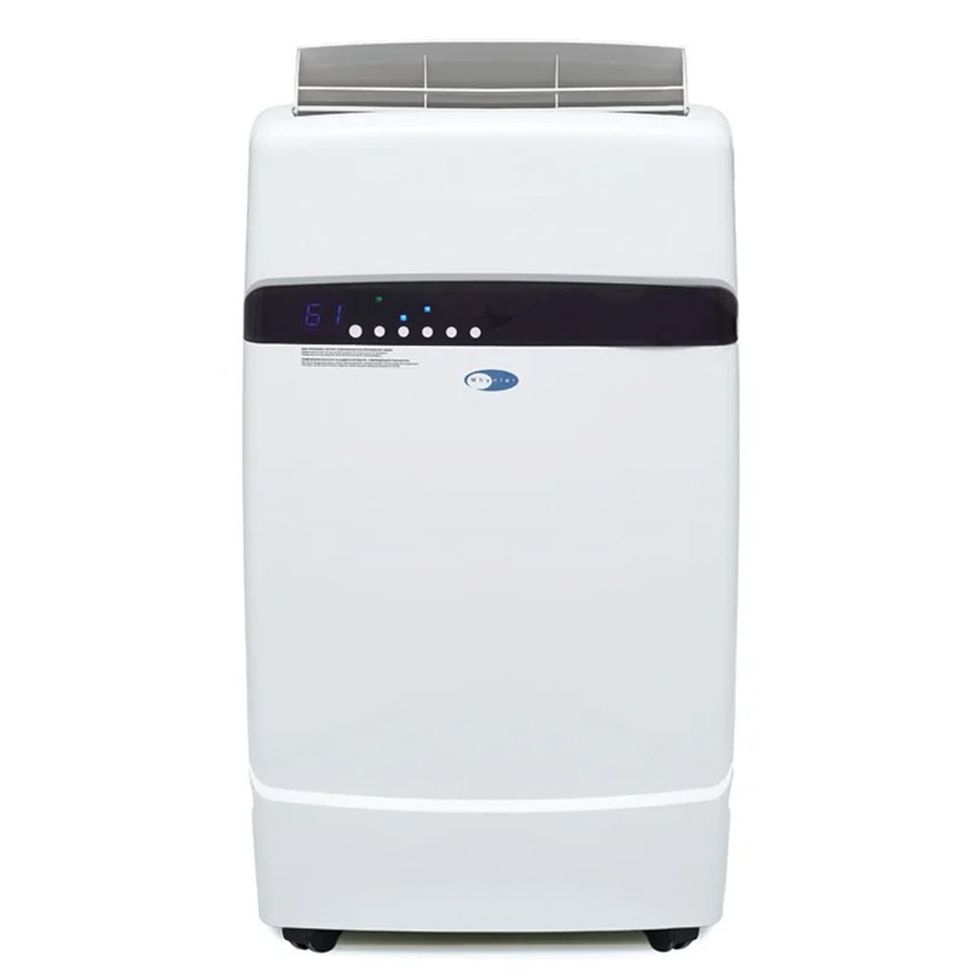
Pros
Dehumidifier, fan, heater and cooler in one
Easy-to-read display
Programmable
Cons
Uses more energy than most tested models
BTU: 12,000 ASHRAE (7,900 SACC) | Exhaust type: Dual hose | Cooling area: 400 sq. ft. | Weight: 71 lbs | Dimensions: 20'' x 16.5'' x 34''
Why we love it: This all-in-one cooler, dehumidifier, fan and heater will get you through the year with its multi-functionality.
Standout features: Whynter claims this unit can cool up to 400 square feet, and it can dehumidify up to 96 pints of moisture over 24 hours.
How it performed in our tests: Like the other Whynter models we looked at for this report, it consumes more energy than competing portable ACs, but that's the tradeoff for its versatility and exceptional cooling power.
How it compares: The two-hose operation helps it cool a room faster than single-hose portable ACs, and the front-facing read-out allows you to monitor the temperature with ease. You can program it for up to 24 hours.
Pros
Works as a cooler or a heater
Battery backup means you can take it on the road
Small, but powerful
Cons
Cooling output is on the lower end
BTU: 5,100 | Exhaust type: Dual hose | Cooling area: 107 sq. ft. | Weight: 32 lbs | Dimensions: 13" x 12" x 20"
Why we love it: EcoFlow’s Wave 2 was a past winner in Good Housekeeping's Home Reno Awards based on the strength of its innovative design, which combines cooling and heating capabilities in a single machine.
Standout features: It includes a battery pack that can be charged at an AC outlet, DC car charger or solar panel, so it can deliver up to eight hours of off-the-grid comfort.“We really like this combo unit for homeowners who live in four-season climates and need portable AC during the summer months and a space heater come winter,” said Scherma.
How it performed in our tests: During initial Lab tests, our engineers were impressed by the innovative mechanics of the two-in-one unit, though they noted that its 5,100 BTU cooling capacity is on the lower end of the spectrum for portable ACs.
How it compares: Unique for its battery-powered design, this compact unit is a cooler and heater, making it suitable for on-the-go use. Despite its small size, it delivers impressive performance.
How we test portable air conditioners
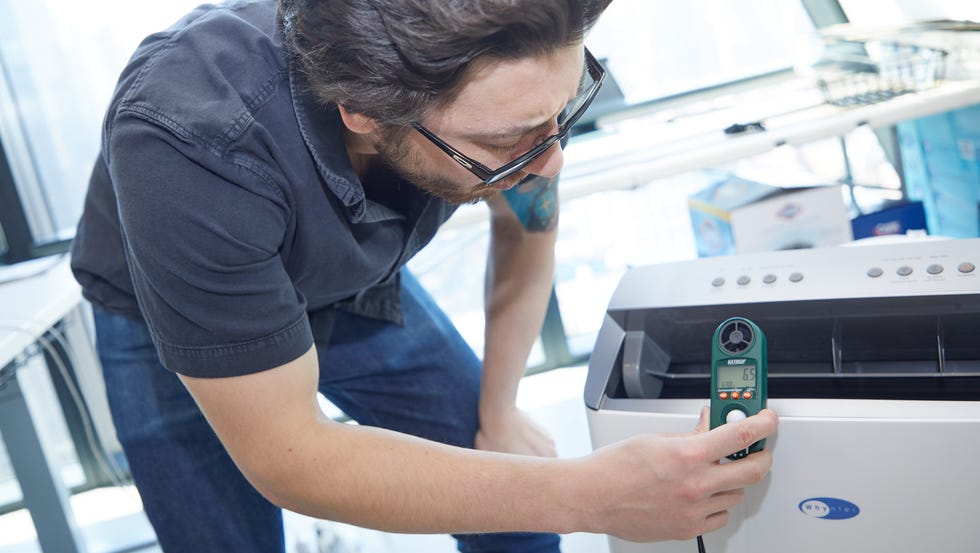
Our Good Housekeeping Institute product experts start by shopping the current marketplace to identify the top-selling portable ACs that you’re most likely to find at stores and online. Next, we identify brands that have performed the best and proven the most reliable through years of AC testing at the Institute. We also consider newer brands with unique features or innovations.
Hands-on evaluations mainly happened in our Home Improvement and Outdoor Lab, where our engineers and experts spent more than 100 hours testing and reviewing 30 new models and analyzing scores of technical data.
Performance testing covers multiple factors. We check to see how close the air temperature coming out of the AC is to our set point. Next, we measure air speed with an anemometer (pictured). This tells us how quickly the AC can cool a room.
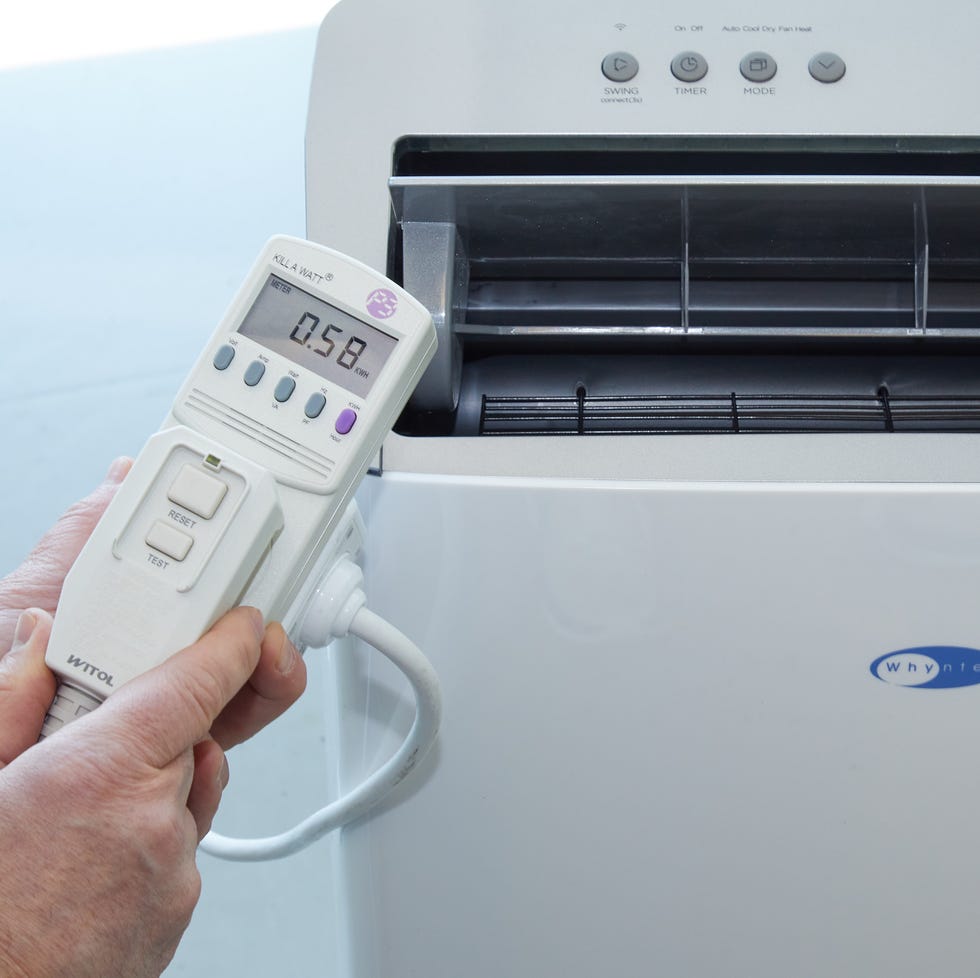
We then assess how much power each device consumed using a Kill-a-Watt electricity usage monitor (pictured). Knowing that portable ACs are often used in bedrooms, we check decibel ranges at various fan speeds using a sound meter.
We also tested some units at home over a six-week period to better evaluate them in real-world conditions. Our engineers consider a variety of factors, starting with ease of set-up. We take into account how intuitive the user manuals and other instructions are.
What to look for in a portable AC

Portable ACs require a single or dual hose for exhausting leftover heat through a vented window. The best choice for you will come down to a few factors.
✔️ Single-hose portable AC: This is the most common type of portable air conditioner and also the least expensive. So if you're on a tight budget, it's your best bet. It features one exhaust hose which vents heat from the unit to the outside. Air to be cooled is pulled directly from the room.
This negative pressure in the room can pull hot air from outside which makes it harder for the AC to maintain consistent temperatures. For this reason, our experts say single-hose ACs are generally best for smaller spaces (200 square feet or less) where the heat and humidity aren't too extreme.
✔️ Dual-hose portable AC: These units feature two hoses that usually connect to the same window — one to take air in and one to exhaust it. Using outside air to cool the system instead of air from the room eliminates the negative pressure issue.
That's why our experts say to go for a dual-hose unit if you need to cool a larger space that can get quite hot and humid. It will be more effective at keeping the room cool and it will use less energy in the process since the motor won't have to work as hard.
✔️ Evaporative Coolers: These types of coolers are portable, but they do not have exhaust hoses. The only moving part is the internal fan that moves air across a water reservoir and cooling pads. ECs produce more of a cool breeze than a blast of cold air; they're ideal in dry climates where humidity levels are low and the air is hot. Since they don't need to be exhausted, you can use ECs in any space, or even outside.
How many BTUs should a portable AC be?

BTUs are a measure of air conditioner capacity that equates to a particular room size. Choosing the right capacity is essential: Too strong and you’ll waste unnecessary power, too weak and it won't cool effectively and will waste energy by continuously running at full tilt. That's why the Department of Energy (DOE) recommends an average of 20 BTUs for each square foot of living space.
✔️ When to size down in BTUs: After you calculate BTUs based on room size, you might find that you're in between offered sizes. Our experts say it's better to opt for the smaller unit. Using too powerful of an AC can be detrimental to the cooling and the comfort of the room.
✔️ When to size up in BTUs: It's important to recognize that not all rooms are built the same. You’ll want to size up your AC if it is in a room with the following:
- High ceilings that create more space that needs to be cooled
- High traffic as more people means more heat generated
- Lots of sun (e.g. a room with a lot of south-facing windows)
- Near the kitchen with a lot of heat-generating appliances
Note: The industry uses two different BTU ratings: SACC and ASHRAE. Short for Seasonally Adjusted Cooling Capacity, SACC is a newer rating system that considers real-world conditions, like indoor temperature and humidity levels. ASHRAE, short for American Society of Heating, Refrigerating, and Air-Conditioning Engineers, is based on controlled lab conditions with consistent temperatures.
Are portable air conditioners as good as window units?

Short answer: no. Window ACs cool more effectively and efficiently than portable units, because their heat-generating mechanical parts are located outside of the room that's being cooled.
- Portable ACs are easier to move. They're on wheels after all. Window ACs need to be properly secured, held in place and connected to the window.
- Portable ACs fit more window types. Another benefit of a portable AC's exhaust hose is that it allows the unit to connect to different window types. While window ACs only work with vertical double-hung windows, portable ACs work with horizontal sliding windows as well.
- Portable ACs are noisier and heavier than window ACs. Portable units tend to be louder, since all their mechanicals are sitting right there in the room, instead of out the window. They can also be larger than their counterparts, weighing up to 80 pounds.
- Portable ACs take up more square footage than window ACs. Because they sit inside the room they cool, portable ACs unit take up more floor space. Our experts recommend placing the unit away from walls so the airflow isn’t restricted, but that will likely mean a longer hose and more space taken up.
Do portable ACs have to be vented out a window?

Standard portable ACs must be vented with a hose out a window to exhaust the hot air they produce. You can also choose to vent through a wall or ceiling — anything that will send the hot air to another space. The machines don't produce toxic fumes, like carbon monoxide, so the venting is about cooling performance, not safety.
However, evaporative coolers don't need to be vented. These units require a large amount of water or ice to cool the space.
Why trust Good Housekeeping?

For many decades, the Good Housekeeping Institute has provided expert reviews and advice on all things home-related, including portable air conditioners and other HVAC equipment. This project was spearheaded by Alec Scherma, test engineer at the Institute. Scherma's background in mechanical engineering and HVAC consulting provides testing expertise and knowledge on the different types of HVAC equipment one can purchase.
Scherma worked closely with Dan DiClerico, director of the Home Improvement & Outdoor Lab. DiClerico brings more than 20 years of experience to the Institute, having reviewed thousands of home-comfort products, including room air conditioners, air purifiers, space heaters, humidifiers and more.
Having written thousands of product reviews and how-to articles on all aspects of home ownership, from routine maintenance to major renovations, Dan (he/him) brings more than 20 years of industry experience to his role as the director of the Home Improvement & Outdoor Lab at the Good Housekeeping Institute. A one-time roofer and a serial remodeler, Dan can often be found keeping house at his restored Brooklyn brownstone, where he lives with his wife and kids.
Alec Scherma (he/him) is the Good Housekeeping Institute’s test engineer, where he helps to create and implement new product testing methodology across home, cooking and cleaning appliances, wellness, tech products and more. He graduated from Drexel University’s College of Engineering with a B.A. in mechanical engineering.

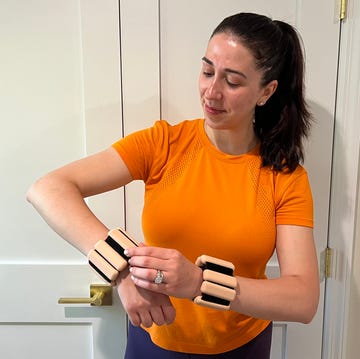
Bala Bangles Review: A Trainer's Perspective
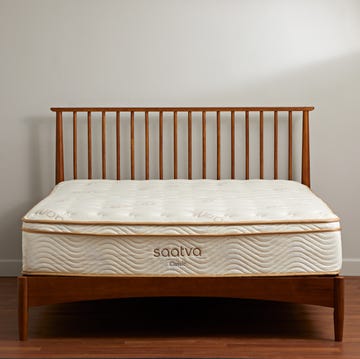
The Best King Size Mattresses
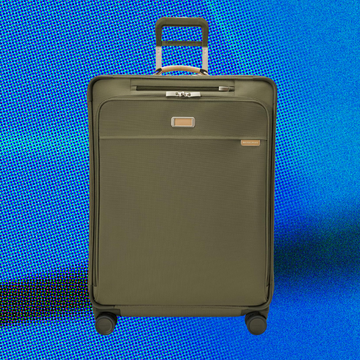
The Best Luggage for International Travel
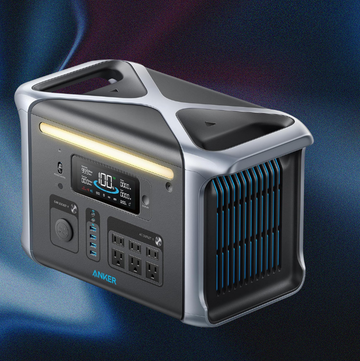
The Best Solar-Powered Generators

